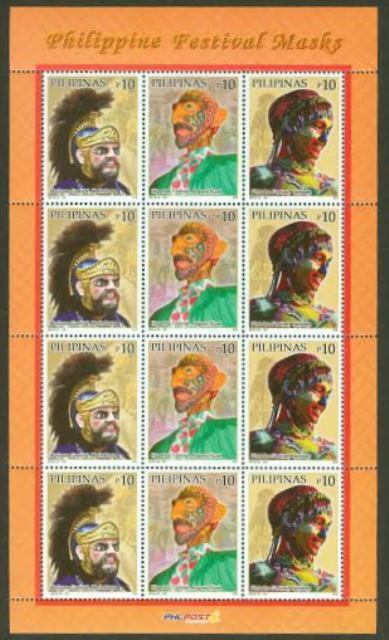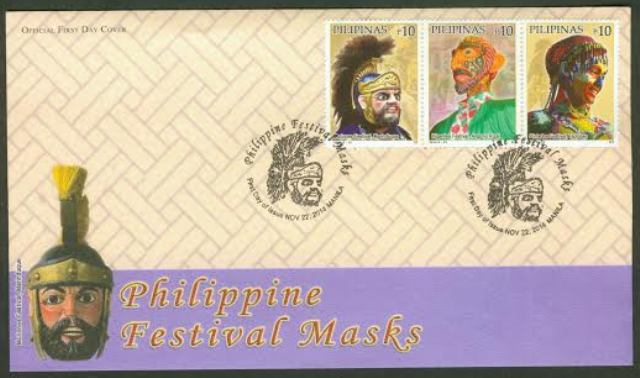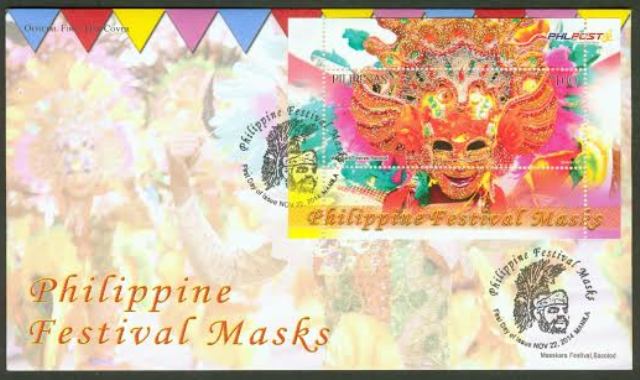2014, November 22. Festival Masks of the Philippines
Litho Offset, Amstar Company, Inc., Perf. 14
Se-tenant Strips of 3, Miniature Sheets of 12; Souvenir Sheets of One



Se-tenant Strips of Three (40,000)
10p Moriones Festival by Jose Antonio A. Jayme
10p Higantes Festival by Nemesio Miranda
10p Pintados Festival by Donald Tapan
Miniature Sheets of 12 (10,000)
Souvenir Sheets of One (5,000)
100p Masskara Festival by Antonio M. Carranza Jr.
Layout Artist: Jose Antonio A. Jayme
First Day Covers: Manila

Festival Masks of the Philippines
Moriones Festival, Marinduque. An annual festival held on Holy Week on the island of Marinduque in the towns of Boac, Gasan, Santa Cruz, Buenavista and Mogpog, Philippines. The origin of the festival is traced to Mogpog in 1870 when the parish priest of said town, Fr. Dionisio Santiago, organized it for the first time. The "Moriones" are men and women in costumes and masks replicating the garb of biblical Roman soldiers as interpreted by local folks. The Moriones or Moryonan tradition has inspired the creation of other festivals in the Philippines where cultural practices or folk history is turned into street festivals. The participants use morion masks to depict the Roman soldiers and Syrian mercenaries within the story of the Passion of the Christ. The mask was named after the 16th and 17th century Morion helmet. The Moriones refers to the masked and costumed penitents who march around the town for seven days searching for Longinus, a Roman centurion who was blind in one eye. Morions roam the streets in town from Holy Monday to Easter Sunday scaring the kids, or engaging in antics or surprises to draw attention. The island becomes one gigantic stage. It is almost certain that the word "Moriones" was derived from "Moros".
Higantes Festival, Angono, Rizal. It was said that the higantes (giants) started during the Spanish colonial times, It was borrowed to Kampong of Binangonan. when Angono was once a hacienda and ruled by Spanish hacienderos The Guido. The Angono land tillers way of protesting their struggle is by making giant effigy of their landlords whose hands are usually high up on their waist. The body of the traditional higante are made of bamboo and colorful cloth and its faces of paper mache. The three old higantes of Angono consists of the family of giants – the father, mother and child higante, they traditionally add color and fun during the fiesta celebration. It was in the late 80s when the late Angono artist Perdigon Vocalan brought the idea of the Higantes Festival by going out of the traditional family of giants and advocating having more higantes in the fiesta by coordinating with the barangays of Angono to come up with Higantes that
will represent their barangay.Pintados Festival, Tacloban. A cultural-religious celebration in Tacloban based on the body-painting traditions of the ancient tattooed "pintados" warriors. In 1986, the Pintados Foundation, Inc. was formed by the people of Tacloban to organize this festival in honor of Sr. Santo Niño. Years later, it was merged with the Kasadyaan Festival which is always held on June 29. Pintados was the term used by Spanish colonists to describe indigenous people with tattooed bodies residing on the islands of Cebu, Bohol, and Leyte in the Biçayas (Visayas) region of the Philippines. The word itself means "painted," and was first used during the Spanish colonization of the Philippines. The men are known for their tattoo art, which often covers most of their bodies.
Masskara Festival (Hiligaynon: Pista sang MassKara, Filipino: Fiesta ng MassKara). A festival held each year in Bacolod,Philippines, every third weekend of October nearest October 19, the city's Charter anniversary. The festival first started in 1980 during a period of crisis. The province relied on sugar cane as its primary agricultural crop, and the price of sugar was at an all-time low due to the introduction of sugar substitutes like high fructose corn syrup in the United States. It was also a time of tragedy; on April 22, 1980 the inter-island vessel MV Don Juan carrying many Negrenses, including those belonging to prominent families in Bacolod City, collided with the tanker Tacloban City and sank. An estimated 700 lives were lost in the tragedy. In the midst of these tragic events, the city's artists, local government and civic groups decided to hold a festival of smiles, because the city at that time was also known as the City of Smiles.
-
Festivals
-
Costumes / Masks
